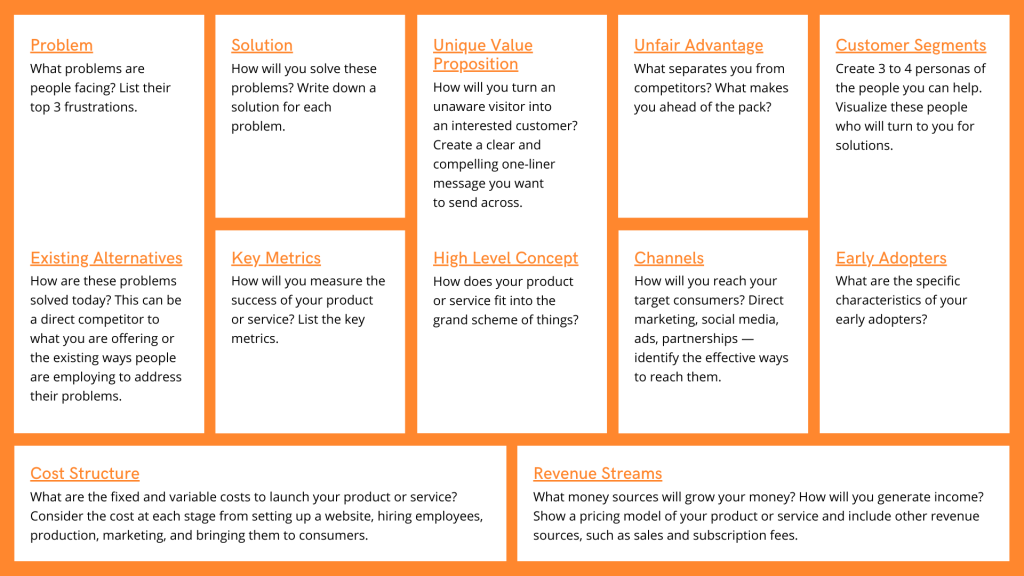In the fast-paced world of product development, creating and also maintaining an effective product strategy can be a daunting task. The Lean Canvas, a variation of the Business Model Canvas adapted by Ash Maurya, simplifies this process. It’s an agile, straightforward framework designed for product leaders, entrepreneurs and startups to quickly sketch out their business models and also product strategies.

Let’s Look into each step of the Lean Canvas
1. Customer Segments
Define your target market. Who are your customers? Segment them based on demographics, behaviours, or needs. Understanding your customer is crucial for tailoring your product strategy to meet their specific requirements.
One tool that could be helpful here is Proto Personas.
Netflix targets a broad range of customers, from young adults seeking the latest TV shows to families looking for diverse entertainment options. They may segment their audience by viewing preferences, age groups, and also even geographical locations.
Netflix’s early adopters were movie buffs and tech-savvy individuals who were already familiar with using the internet for entertainment. These customers were quick to appreciate the convenience and also novel approach of online streaming.
2. Problems
What are the problems of our customers especially early adopters?
Answers to this question form the foundation of your product strategy. List out the top problems your target customers face, which your product or service intends to address.
For Netflix, this would be limited access to movies and TV shows without late fees or due dates.
Existing Alternatives such as Traditional rental services were inconvenient and often expensive for consumers.
3. Unique Value Proposition
What sets your product apart? Why your customers should choose your product or service?
Your Unique Value Proposition (UVP) should clearly state why your product is different and better than the competition. It should be compelling enough to attract customers. Hence, this step may require competitor analysis.
Netflix’s UVP is its vast library of movies and TV shows available on-demand, with personalized recommendations. This convenience and customization set Netflix apart from traditional cable services and also movie rental stores.
4. Solution
How your product or service will solve customers’ problems?
Outline the solutions your product offers to the problems identified. Be specific about how your product addresses these issues. This section directly ties back to the previous steps: Customer Segments, Problems and UVP.
The solution provided by Netflix includes streaming a wide variety of content, including original productions, accessible from multiple devices anywhere, anytime.
High-Level Concept: On-Demand Streaming, Personalised Viewing Experience, Original & Diverse Content.
5. Channels
How we will reach customers?
Determine the pathways to reach your customers. Channels can include various marketing and also distribution methods. Choosing the right channels is essential for ensuring your product reaches its also intended audience effectively.
Netflix uses its website and mobile apps as primary channels. They also leverage social media and partnerships with smart TV manufacturers and ISPs to increase accessibility.
6. Revenue Streams
How Your Product Will Make Money?
Define how your product will make money. What are your revenue models and also Pricing Strategies– subscriptions, one-time sales, freemium, etc.? This is where you outline your business’s financial sustainability.
Learn More: Pricing As A Double-loop Learning Process
Netflix generates revenue through subscription-based models with different tiers based on streaming quality and the number of screens that can access the account simultaneously.
7. Cost Structure
What are the key costs?
Identify the costs involved in bringing your product to market. This includes development, architecture, production, marketing, staff, and also any other operational costs. Understanding your cost structure is vital for pricing your product appropriately.
Major costs for Netflix include content acquisition, production of original series and also films, technology infrastructure, and marketing. Understanding these costs is essential for their pricing strategy also.
8. Key Metrics
How we will measure progress towards our goals?
Determine the key metrics that will help you measure the success of your product also. These could include customer acquisition cost, lifetime value, churn rate, etc.
Explore Evidence-Based Management
Key metrics for Netflix include subscriber growth, churn rate, engagement metrics like average watch time, and also content performance.
9. Unfair Advantage
What is something about your product or also service that can not be easily copied or bought?
What is your secret sauce? It could be your expert team, patents, proprietary technology, or also personal networks.
Netflix’s unfair advantage lies in its strong brand, proprietary content recommendation algorithm, and also an extensive library of original content that can’t be found elsewhere.
Conclusion
The Lean Canvas is a powerful tool for crafting a focused and also effective product strategy. It forces you to distill your product’s essence and value and also to continually iterate and refine your strategy based on feedback and market dynamics. Embrace the Lean Canvas, and also you’ll be well on your way to developing a product strategy that resonates with your target market and sets you up for success.

